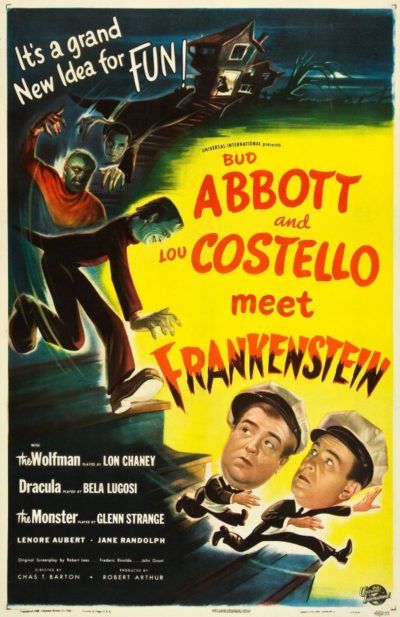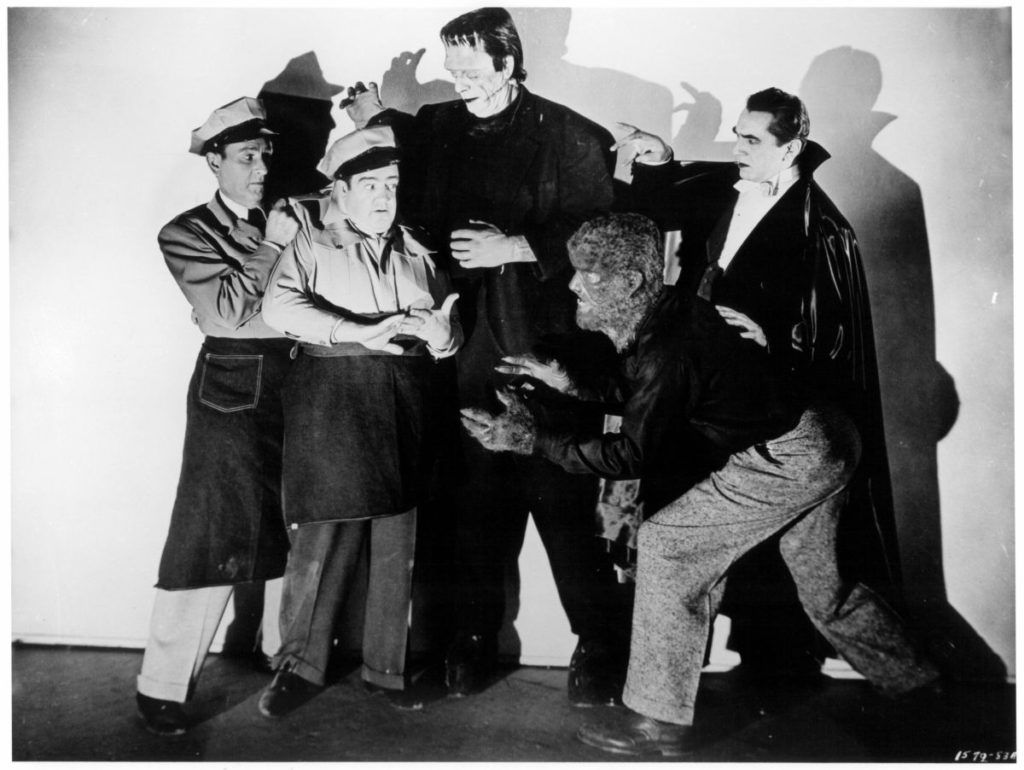
Rating: B-
Dir: Charles Barton
Star: Bud Abbott, Lou Costello, Bela Lugosi, Lon Chaney Jr.
Is this a vampire film? Or, just a film which has a vampire in it? This is a valid question, and a significant distinction. However, the deciding factor for me, is that it’s not just any vampire: it’s Count Dracula. And it’s not just any Count Dracula: it’s motherfucking Bela Lugosi. So, yeah. Even if this is a comedy romp, one which started the “Abbott and Costello Meet…” franchise. Even if it basically killed off the concept of vampires for a decade (at least in English language cinema), because nobody could take them seriously after this. Even if Chaney said, “Abbott and Costello ruined the horror films: they made buffoons out of the monsters.” It is still starring the godfather of vampire actors, as the godfather of vampires. It’s a vampire film.
That said, it has to be admitted, it is not your typical vampire film. Dracula (Lugosi) behaves more like Baron Frankenstein, being interested in upgrading the manufactured creature, because… Well, I’m not sure. No explanation for this sudden interest in cutting-edge science is ever given. Before we go any further, this is where I am compelled to mention that the title is “wrong”, since at no point do our heroes meet Frankenstein. Should it be called Abbott and Costello Meet Frankenstein’s Monster? Then again, you had Bride of Frankenstein: unless Henry is intending to marry his female creation, this title must refer to his first attempt. So seems the snippy “Frankenstein isn’t the name of the monster” argument might be wrong in some cases…
 The shenanigans here take place in Florida, beginning at the train station where Chick Young (Costello) and Wilbur Grey (Abbott) are baggage handlers. They’re tasked with bringing two large crates containing Dracula’s coffin and Frankenstein’s monster to “McDougal’s House of Horrors”, a nearby wax museum. They do so, only for the Count (Lugosi) to arise, and reactivate the creature. Both vanish, leaving the caretakers on the hook, and briefly in jail, for the loss. Dracula wants a more obedient brain in the monster, and works with Dr. Sandra Mornay to that end. Guess who’s brain is perfectly pliable? Yep: Wilbur’s. Complicating matters further, there’s an insurance agent running around, who believes Chick and Wilbur stole the exhibits. Finally – as if that wasn’t enough – we have Lawrence Talbot (Chaney), a werewolf trying to stop Dracula.
The shenanigans here take place in Florida, beginning at the train station where Chick Young (Costello) and Wilbur Grey (Abbott) are baggage handlers. They’re tasked with bringing two large crates containing Dracula’s coffin and Frankenstein’s monster to “McDougal’s House of Horrors”, a nearby wax museum. They do so, only for the Count (Lugosi) to arise, and reactivate the creature. Both vanish, leaving the caretakers on the hook, and briefly in jail, for the loss. Dracula wants a more obedient brain in the monster, and works with Dr. Sandra Mornay to that end. Guess who’s brain is perfectly pliable? Yep: Wilbur’s. Complicating matters further, there’s an insurance agent running around, who believes Chick and Wilbur stole the exhibits. Finally – as if that wasn’t enough – we have Lawrence Talbot (Chaney), a werewolf trying to stop Dracula.
It is interesting the film’s title focuses on Frankenstein, when that’s the one not played by his originator. Boris Karloff vowed not to return to the role of the monster after Son of Frankenstein, though did agree to help out her by doing publicity for it. Instead, the role is played by Glenn Strange, who took over from Karloff for Universal. You’d also think the studio would have capitalized on getting Lugosi back into the cape of Dracula for only the second time, seventeen years after his classic performance. On the other hand, the film does include another horror icon, albeit one who was just a well-regarded character actor at this point. For the voice of the Invisible Man, who has a cameo “non-appearance” at the end, was provided by Vincent Price. While they never share the screen, it’s the only feature film in which Price and Lugosi both took part.
I see Chaney’s point, admittedly. This horror comedy skews almost entirely to the latter. The basic concept – unwilling brain transplant – falls into the horror genre, yet the execution is relentlessly lighthearted. Dracula doesn’t do much in the way of vamping, preferring to use his hypnosis talents, with Dr. Mornay his only true victim. He operates mostly under the pseudonym of Dr. Lejos, and his eventual demise at the hands of the Wolfman is underwhelmingly off-screen. Weirdly, Mornay gets the worst death, bodily tossed out the window by Franky. This was a semi-cursed stunt which first broke Strange’s ankle, then – depending on the source – either caused stuntwoman Helen Thurston to be taken to hospital with candy glass in her eyes, or injured her hip.
 I do have to acknowledge the lovely animated effect when Count Dracula shifts into and out of his form as a bat. While Walter Lantz is often credited with this (not least by the IMDb), there’s some suggestion it may have been Dave Fleischer who was responsible. If not “realistic”, it likely works better to modern eyes than the transformation of Cheney into a wolf, which looks every inch its 75-year age. The scripting from this angle isn’t much better. For instance, Talbot turns into a werewolf because he was bitten by one. Yet, he bites McDougal, who doesn’t turn, even though it’s the night of a full moon (every night is, for this movie’s purposes!). It’s all very sloppy, and you understand why Costello initially turned the film down, allegedly saying, “No way I’ll do that crap. My little girl could write something better than this.” A fifty grand advance convinced Bud of the script’s merits.
I do have to acknowledge the lovely animated effect when Count Dracula shifts into and out of his form as a bat. While Walter Lantz is often credited with this (not least by the IMDb), there’s some suggestion it may have been Dave Fleischer who was responsible. If not “realistic”, it likely works better to modern eyes than the transformation of Cheney into a wolf, which looks every inch its 75-year age. The scripting from this angle isn’t much better. For instance, Talbot turns into a werewolf because he was bitten by one. Yet, he bites McDougal, who doesn’t turn, even though it’s the night of a full moon (every night is, for this movie’s purposes!). It’s all very sloppy, and you understand why Costello initially turned the film down, allegedly saying, “No way I’ll do that crap. My little girl could write something better than this.” A fifty grand advance convinced Bud of the script’s merits.
If an almost complete failure as horror, I found the comedy surprisingly funny, and genuinely LOL’d on a number of occasions. I was expecting it to be pure slapstick, yet it’s not all physical, with a good amount of verbal play too, and it balances between these two elements to good effect. It’s far from the first horror comedy, a sub-genre going back at least as far as Harold Lloyd’s 1920 silent, Haunted Spooks. However, this perhaps broke the mould in terms of its tremendous commercial success. Despite being one of Universal’s cheapest productions of 1948, at under $800,000, it was among their highest grossing, bringing back four times its budget. The careers of Abbott and Costello were revived, though perhaps at the cost of the American audience taking vampires seriously. It would be another decade before Hammer would bring the Count back, and considerably longer before any major Hollywood studio wanted to re-open Dracula’s vault. As we’ll shortly see, other countries did not feel anything like the same reluctance.
This review is part of our October 2023 feature, 31 Days of Vampires.
